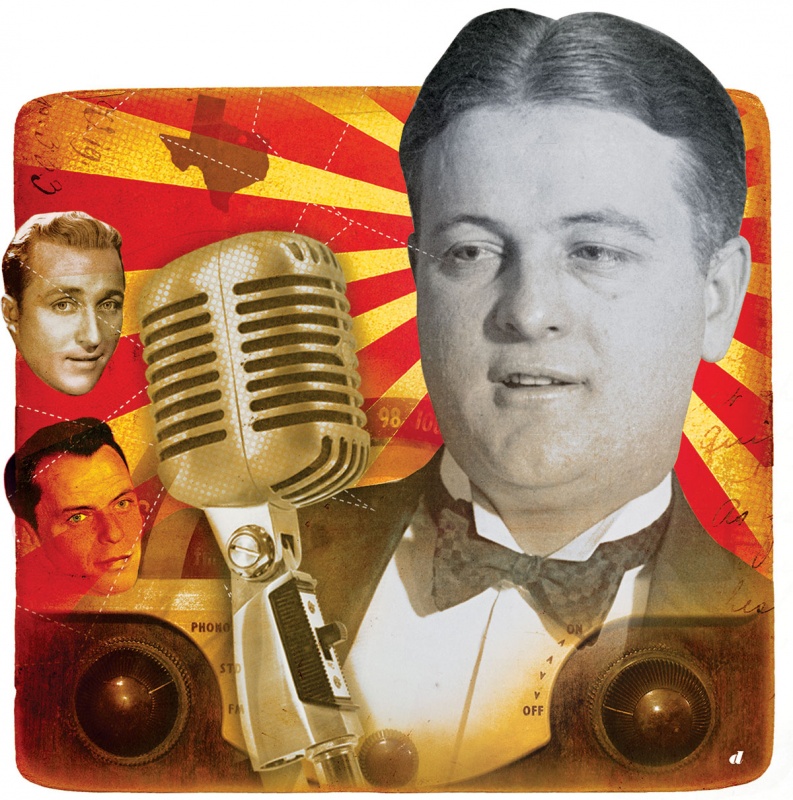He’s credited with creating the vocal style known as crooning, and during the six-year peak of his career in the late 1920s and early ’30s, he sold some 86 million records. Several of his songs became standards that are still sung today. Known as “The Voice of the Southland,” he was an iconic figure to an emerging Southern middle class. Gene Austin, born Lemuel Eugene Lucas in Gainesville, Texas, in 1900, was a towering figure in early 20th-century American pop culture. Yet today, he’s barely remembered.
Austin rode new technology to the top of the charts. He cut his first record, the self-composed When My Sugar Walks Down the Street, a duet with Aileen Stanley, in 1925, the year after electronic recording was introduced. Acoustic re-cording until that time required a full-throated vocalist to belt lyrics into a cone-shaped device called a horn, which couldn’t fully catch the sounds.
The electronic system allowed the vocalist to sing into a microphone, which more accurately captured not only different volumes (allowing singers to raise and lower their voices for dramatic effect) but also the nuances of an individual’s voice (so they could phrase lyrics more subtly).
The radio-friendly result sounded warm and intimate, as if the vocalist was singing directly to each listener, and it proved a perfect foil for Austin’s delicate, high tenor. He and others, including Rudy Vallee, ran with this new technique, which was later perfected by the likes of Bing Crosby and Frank Sinatra (both of whom credited Austin with initiating the style). Crooning remained the dominant form of pop singing until rock ’n’ roll took over in the mid-1950s.
Before his breakthrough, Austin led a vagabond life. His parents divorced when he was 6, and his mother soon married a blacksmith named Jim Austin, who gave the child his own surname and moved the family to swampy Yellow Pine, Louisiana, about 30 miles east of Shreveport.
To avoid his belligerent stepfather, Austin began sneaking off to the African-American area known as “The Quarters,” where he embraced a mentor he called Uncle Esau and fell hard for black singing styles. At 16, he fled home for good, hoboing around the South. Then came two Army stints, followed by time in Baltimore studying dentistry and law.
Finally, after he sought to crack vaudeville as one half of the comic duo Roy and Gene, he had a hit with the 1924 original How Come You Do Me Like You Do? That took the team to New York, where they broke up. Then, Austin hired on with Irving Mills Music as a songwriter and song plugger, with the job of inducing other artists to perform material from the company’s catalog.
Once his own singing career began, Austin’s familiarity with the Mills inventory enabled him to find good tunes that other vocalists were ignoring. That’s how he unearthed early hits he didn’t write, including Five Foot Two, Eyes of Blue and Yes Sir, That’s My Baby, and that’s how in 1927 he became the first to cut My Blue Heaven. That hit went on to sell at least 5 million records (some estimates go as high as 12 million) and became his signature song. Austin also put Bye Bye Blackbird on the map in ’26 and Ramona in ’28.
The Lonesome Road, a secular spiritual he wrote in 1927, was Franklin D. Roosevelt’s favorite song and eventually found its way into the musical Show Boat. Americans, especially in the South, couldn’t get enough of the soft, seductive style of the “Genial Texan,” as he was sometimes dubbed, and if they listened closely to some hits, they could even detect a bit of an accent. Performing in a suit and tie, he lent respectability to Southern singers, who’d previously been stereotyped as blackface minstrels and vaudevillians or working-class country and blues bums.
But almost as soon as he began hitting, Austin discovered the high life. He claimed he began drinking to excess to buffer the phoniness of show biz and because he was unhappy his record company wouldn’t let him record the black material he wanted to expose to white America (though he did release his friend Fats Waller’s Ain’t Misbehavin’ even before Waller did). Whatever the case, he lived it up in Harlem speakeasies, developing a reputation as a hard man to work with, as wives began to come and go—five in all. Between that and the Depression, his snowballing career began to melt instead.
He fell back on his fondness for the South, moving to New Orleans and then Charlotte, North Carolina, and eventually running a traveling tent show. He then went out to Hollywood, taking roles in three movies and opening a nightclub, My Blue Heaven. There were regular radio shows, and periodic attempts at a national comeback, none more than moderately successful.
In 1962, with a new My Blue Heaven anchored in Las Vegas, he ran for governor of Nevada but was roundly trampled. By the time he died of lung cancer in Palm Springs, California, in 1972, he’d been virtually forgotten. But Southerners like Austin were the backbone of American popular music.
——————–
John Morthland is an Austin writer.


